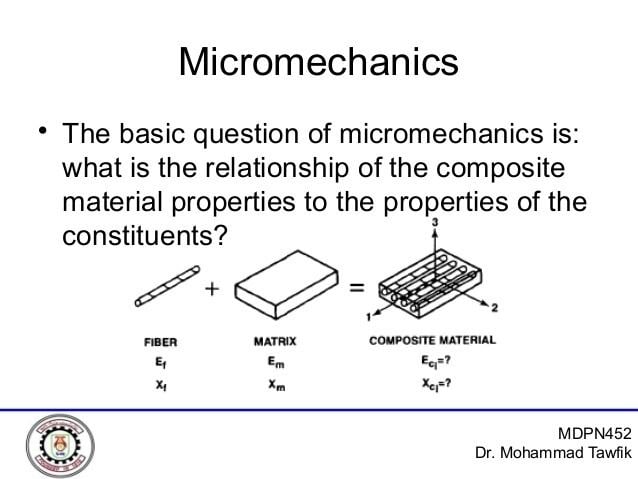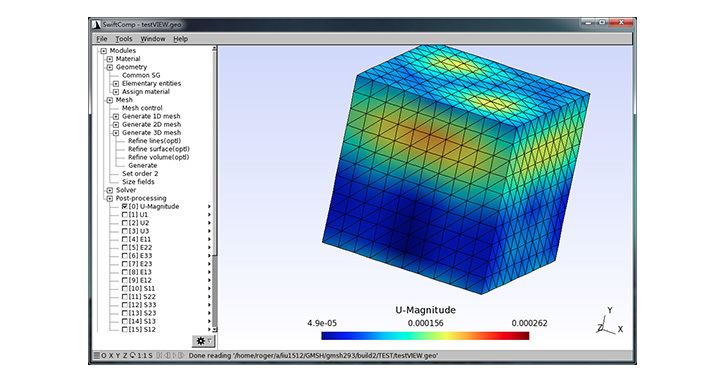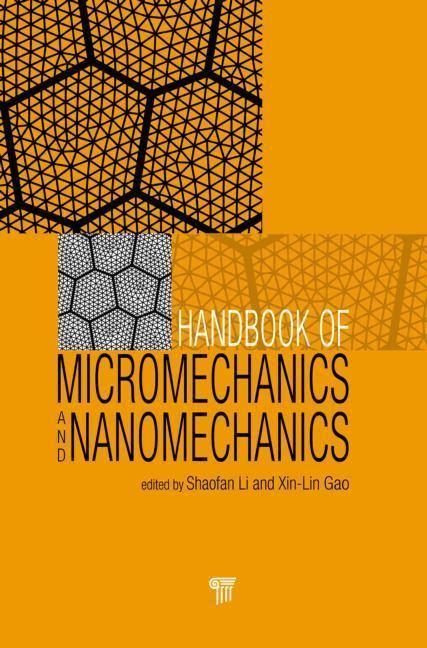 | ||
307 l7 micromechanics of titanium alloys
Micromechanics (or, more precisely, micromechanics of materials) is the analysis of composite or heterogeneous materials on the level of the individual constituents that constitute these materials.
Contents
- 307 l7 micromechanics of titanium alloys
- Nano and micromechanics kathy walsh
- Aims of micromechanics of materials
- Analytical methods of continuum micromechanics
- Methods based on Finite Element Analysis FEA
- Generalized Method of Cells GMC
- Mechanics of Structure Genome MSG
- References

Nano and micromechanics kathy walsh
Aims of micromechanics of materials

Heterogeneous materials, such as composites, solid foams, polycrystals, or bone, consist of clearly distinguishable constituents (or phases) that show different mechanical and physical material properties.
Given the (linear and/or nonlinear) material properties of the constituents, one important goal of micromechanics of materials consists of predicting the response of the heterogeneous material on the basis of the geometries and properties of the individual phases, a task known as homogenization. The benefit of homogenization is that the behavior of a heterogeneous material can be determined without resorting to testing it. Such tests may be expensive and involve a large number of permutations (e.g., in the case of composites: constituent material combinations; fiber and particle volume fractions; fiber and particle arrangements; and processing histories). Furthermore, continuum micromechanics can predict the full multi-axial properties and responses of inhomogeneous materials, which are often anisotropic. Such properties are often difficult to measure experimentally, but knowing what they are is a requirement, e.g., for structural analysis involving composites. To rely on micromechanics, the particular micromechanics theory must be validated through comparison to experimental data.

The second main task of micromechanics of materials is localization, which aims at evaluating the local (stress and strain) fields in the phases for given macroscopic load states, phase properties, and phase geometries. Such knowledge is especially important in understanding and describing material damage and failure.

Because most heterogeneous materials show a statistical rather than a deterministic arrangement of the constituents, the methods of micromechanics are typically based on the concept of the representative volume element (RVE). An RVE is understood to be a sub-volume of an inhomogeneous medium that is of sufficient size for providing all geometrical information necessary for obtaining an appropriate homogenized behavior.

Most methods in micromechanics of materials are based on continuum mechanics rather than on atomistic approaches such as nanomechanics or molecular dynamics. In addition to the mechanical responses of inhomogeneous materials, their thermal conduction behavior and related problems can be studied with analytical and numerical continuum methods. All these approaches may be subsumed under the name of "continuum micromechanics".
Analytical methods of continuum micromechanics
Voigt (1887) - Strains constant in composite, rule of mixtures for stiffness components.
Reuss (1929) - Stresses constant in composite, rule of mixtures for compliance components.
Strength of Materials (SOM) - Longitudinally: strains constant in composite, stresses volume-additive. Transversely: stresses constant in composite, strains volume-additive.
Vanishing Fiber Diameter (VFD) - Combination of average stress and strain assumptions that can be visualized as each fiber having a vanishing diameter yet finite volume.
Composite Cylinder Assemblage (CCA) - Composite composed of cylindrical fibers surrounded by cylindrical matrix layer, cylindrical elasticity solution. Analogous method for macroscopically isotropic inhomogeneous materials: Composite Sphere Assemblage (CSA)
Hashin-Shtrikman Bounds - Provide bounds on the elastic moduli and tensors of transversally isotropic composites (reinforced, e.g., by aligned continuous fibers) and isotropic composites (reinforced, e.g., by randomly positioned particles).
Self-Consistent Schemes - Effective medium approximations based on Eshelby's elasticity solution for an inhomogeneity embedded in an infinite medium. Uses the material properties of the composite for the infinite medium.
Mori-Tanaka Method - Effective field approximation based on Eshelby's elasticity solution for inhomogeneity in infinite medium. As is typical for mean field micromechanics models, fourth-order concentration tensors relate the average stress or average strain tensors in inhomogeneities and matrix to the average macroscopic stress or strain tensor, respectively; inhomogeneity "feels" effective matrix fields, accounting for phase interaction effects in a collective, approximate way.
Methods based on Finite Element Analysis (FEA)
Most such micromechanical methods use periodic homogenization, which approximates composites by periodic phase arrangements. A single repeating volume element is studied, appropriate boundary conditions being applied to extract the composite's macroscopic properties or responses. The Method of Macroscopic Degrees of Freedom can be used with commercial FEA codes, whereas analysis based on asymptotic homogenization typically requires special-purpose codes.
The Variational Asymptotic Method for Unit Cell Homogenization (VAMUCH) is a recent Finite Element (FE) based approach for periodic homogenization. This theory was later generalized to be mechanics of structure genome (see below). The companion code SwiftComp can be directly launched in the cloud at https://cdmhub.org/resources/scstandard.
In addition to studying periodic microstructures, embedding models and analysis using macro-homogeneous or mixed uniform boundary conditions can be carried out on the basis of FE models. Due to its high flexibility and efficiency, FEA at present is the most widely used numerical tool in continuum micromechanics. Examples of the practical use of FEA in micromechanics can be found in many disciplines including biomaterials (bone, tendon), construction materials (concrete), and engineering materials (composite).
Generalized Method of Cells (GMC)
Explicitly considers fiber and matrix subcells from periodic repeating unit cell. Assumes 1st-order displacement field in subcells and imposes traction and displacement continuity. It was developed into the High-Fidelity GMC (HFGMC), which uses quadratic approximation for the displacement fields in the subcells.
A further group of periodic homogenization models make use of Fast Fourier Transforms (FFT), e.g., for solving an equivalent to the Lippmann–Schwinger equation. FFT-based methods at present appear to provide the numerically most efficient approach to periodic homogenization of elastic materials.
Ideally, the volume elements used in numerical approaches to continuum micromechanics should be sufficiently big to fully describe the statistics of the phase arrangement of the material considered, i.e., they should be Representative Volume Elements (RVEs). In practice, smaller volume elements must be used due to limitations in available computational power. Such volume elements are often referred to as Statistical Volume Elements (SVEs). Ensemble averaging over a number of SVEs may be used for improving the approximations to the macroscopic responses. Parallel finite element programs such as ParaFEM have enabled researchers to study full size Representative Volume Elements (RVEs) for meshes derived from 3D tomography data.
Mechanics of Structure Genome (MSG)
A unified theory called mechanics of structure genome (MSG) has been introduced to treat structural modeling of anisotropic heterogeneous structures as special applications of micromechanics. Using MSG, it is possible to directly compute structural properties such as stiffness or bending stiffness of a structure in terms of microstructural details. The companion code SwiftComp can be freely executed in the cloud at https://cdmhub.org/resources/scstandard.
